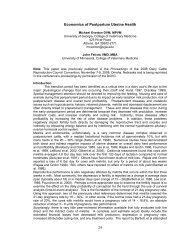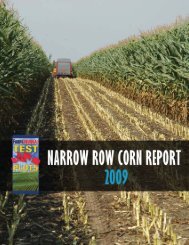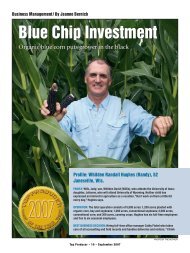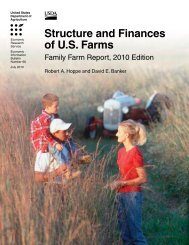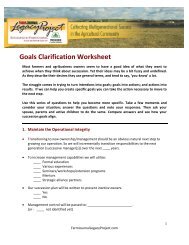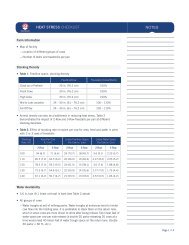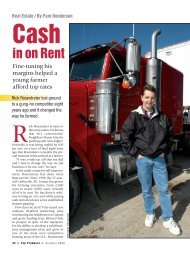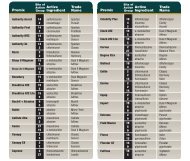Causes of Reproductive Inefficiency in Lactating Dairy Cattle - AgWeb
Causes of Reproductive Inefficiency in Lactating Dairy Cattle - AgWeb
Causes of Reproductive Inefficiency in Lactating Dairy Cattle - AgWeb
Create successful ePaper yourself
Turn your PDF publications into a flip-book with our unique Google optimized e-Paper software.
<strong>Causes</strong> <strong>of</strong> <strong>Reproductive</strong><br />
<strong>Inefficiency</strong> <strong>in</strong> Lactat<strong>in</strong>g <strong>Dairy</strong><br />
<strong>Cattle</strong><br />
Ricardo C. Chebel<br />
Veter<strong>in</strong>ary Medic<strong>in</strong>e Cooperative Extension<br />
University <strong>of</strong> California Davis
Introduction<br />
• Physiological changes<br />
• Energy demands<br />
• Body condition score (BCS) and BCS change<br />
• Impact <strong>of</strong> disease on fertility<br />
• Timed AI protocols<br />
– Critical steps
Physiological Factors Affect<strong>in</strong>g<br />
<strong>Reproductive</strong> Performance
Estimated Lactation Curve For The<br />
"Average" Cow <strong>in</strong> The U.S.<br />
2.2 lb <strong>in</strong>crement <strong>in</strong> peak = 440 lb <strong>in</strong>crement per lactation<br />
110<br />
88<br />
66<br />
44<br />
22<br />
0<br />
2/19/2009 4<br />
Courtesy <strong>of</strong> J.E.P. Santos
Luc<strong>in</strong>da's Lactation: 67,914 lb<br />
At Peak Production: 229 lb/d<br />
-82 Mcal NEl: ~ 33 lb <strong>of</strong> body weight/d<br />
-6.2 kg <strong>of</strong> MP: ~ 45.3 lb <strong>of</strong> body weight/d<br />
Current record = 75,117 lb/lactation<br />
LA Foster Blackstar Lucy 607<br />
ourtesy <strong>of</strong> J.E.P. Santos
Increased Steroid Metabolism = Low Fertility?<br />
53 Mcal/d vs.<br />
12.5 Mcal/d<br />
Results:<br />
• Decr estrous behavior<br />
• Incr size <strong>of</strong> ovulatory follicle<br />
• Incr double ovulation<br />
• Decr embryonic development<br />
• Decr preg rate<br />
• Incr pregnancy loss<br />
Decr. Estradiol<br />
Decr. Progesterone<br />
Wiltbank M. Bov<strong>in</strong>e Reproduction<br />
Workshop - 2001
Effect <strong>of</strong> Milk Yield on<br />
<strong>Reproductive</strong> Performance
Relationship Among Milk Yield, Conception<br />
Rates and Pregnancy Loss<br />
P = 0.60<br />
P = 0.25<br />
1456<br />
1454<br />
1456<br />
1472<br />
1422<br />
1472<br />
1454<br />
1422<br />
P = 0.19<br />
509<br />
566 575 548<br />
P/AI<br />
Santos et al. (2007)
Embryo Quality: Dry vs. Lactat<strong>in</strong>g Cows<br />
Response Dry Lactat<strong>in</strong>g<br />
Fertilization Rate 89.5% 87.8%<br />
% Grade 1-3 82.3% 52.8%<br />
dairy cows are <strong>in</strong>ferior to<br />
embryos from dry cows as<br />
early as 5 days after<br />
Embryos from lactat<strong>in</strong>g<br />
ovulation!<br />
Sartori et al. (2002)
Energy Demands <strong>of</strong> Early Lactation
<strong>Dairy</strong> Cow Lactation Cycle<br />
Energy (demand and supply)<br />
Early<br />
Lactation<br />
Milk<br />
Production<br />
Calv<strong>in</strong>g<br />
Dry Matter<br />
Intake<br />
Mid Lactation<br />
Body Energy Reserves<br />
Late<br />
Lactation<br />
Dry<br />
Period<br />
0 1 2 3 4 5 6 7 8 9 10 11 12<br />
Month <strong>of</strong> Lactation<br />
Fetal Growth<br />
3.5 2.75 3.0 3.25
Energy Balance<br />
Nutrient Intake<br />
Body Condition Loss<br />
Ma<strong>in</strong>tenance<br />
Milk Production<br />
Body Condition Ga<strong>in</strong><br />
Reproduction
• Elephant seals<br />
The Cow is not Alone!<br />
– 28 d lactation (fasten<strong>in</strong>g)<br />
– Pup body weight ga<strong>in</strong>s = 10% <strong>of</strong> BW/d<br />
– Use <strong>of</strong> maternal body reserves<br />
• 42% loss <strong>of</strong> body weight (reduction <strong>of</strong><br />
58% <strong>in</strong> body fat and 14% <strong>in</strong> lean<br />
weight)<br />
• Baleen whales<br />
– 50 x 10 3 kg body weight ga<strong>in</strong> dur<strong>in</strong>g<br />
pregnancy<br />
– 7 mo lactation produc<strong>in</strong>g 90 kg/d <strong>of</strong><br />
milk at ~40% fat and 12% prote<strong>in</strong><br />
– Almost no feed <strong>in</strong>take
Energy Balance<br />
First 7 weeks<br />
<strong>of</strong> Lactation<br />
Input Output<br />
Input<br />
Weeks 8-9 <strong>of</strong> Lactation<br />
Output<br />
Week 10 + <strong>of</strong> Lactation<br />
Input Output
1. Basal metabolism<br />
2. Activity<br />
3. Growth<br />
Partition<strong>in</strong>g <strong>of</strong> Nutrients<br />
4. Energy reserves<br />
5. Pregnancy<br />
6. Lactation<br />
7. Additional energy reserves<br />
8. Estrous cycle and <strong>in</strong>itiation <strong>of</strong> pregnancy<br />
9. Excess energy reserves
Association Between BCS and<br />
Cyclic Status
3.0<br />
> 3.25<br />
3.0 < 2.75<br />
3.25 > 3.25<br />
Elanco Animal Health
Proportion <strong>of</strong> Cyclic Cows at 65 DIM<br />
Accord<strong>in</strong>g to BCS and BCS Change<br />
(6396 lactations)<br />
P = 0.01<br />
P < 0.01<br />
P < 0.01<br />
Lost<br />
BCS 0 DIM<br />
BCS at AI<br />
Change <strong>in</strong><br />
BCS<br />
Santos et al. (2008)
Effect <strong>of</strong> BCS at 65 DIM on Proportion <strong>of</strong><br />
Anovular Cows<br />
n = 6936 lactations<br />
r 2 = 0.97<br />
P < 0.01<br />
Santos et al., 2008
Association Between Resumption<br />
<strong>of</strong> Estrous Cycles and Fertility
Resumption <strong>of</strong> Cyclicity Influences<br />
Time to Pregnancy<br />
1.0<br />
0.9<br />
Cyclic 49 DIM<br />
Cyclic at 62 DIM<br />
Effect <strong>of</strong> day <strong>of</strong><br />
resumption <strong>of</strong><br />
cyclicity: P < 0.001<br />
Proportion not pregnant<br />
0.8<br />
0.7<br />
0.6<br />
0.5<br />
0.4<br />
Anovular at 62 DIM<br />
n = 967 cows<br />
Median days open:<br />
- Cyclic 49 = 123<br />
- Cyclic 62 = 135<br />
- Anovular = 170<br />
0.3<br />
0.2<br />
0<br />
100<br />
200<br />
300<br />
Days <strong>in</strong> milk<br />
R.C. Chebel
Correlation Between BCS and<br />
Change <strong>in</strong> BCS and Fertility <strong>of</strong><br />
Lactat<strong>in</strong>g <strong>Dairy</strong> Cows
Effect <strong>of</strong> BCS at 60 DIM on AI<br />
Submission Rate After Presynchronization<br />
P < 0.01<br />
Santos et al., 2003
Effect <strong>of</strong> BCS at AI on Pregnancy per AI<br />
and Pregnancy Loss<br />
P < 0.01<br />
P < 0.01<br />
P = 0.04<br />
Conception Rate<br />
Pregnancy per AI<br />
Santos et al. (2008)
Effect <strong>of</strong> BCS Change on Pregnancy per<br />
AI and Pregnancy Loss<br />
P < 0.01<br />
P < 0.01<br />
P = 0.01<br />
484 484<br />
137<br />
Conception Rate<br />
Pregnancy per AI<br />
Santos et al. (2008)
BCS and Change <strong>in</strong> BCS Dur<strong>in</strong>g<br />
the Dry Period
Average BCS:<br />
2.84<br />
3.57<br />
4.36<br />
Effect <strong>of</strong> BCS Prepartum on DMI<br />
Hayirli et al. (2002)
Proportion <strong>of</strong> Cows Loos<strong>in</strong>g BCS Accord<strong>in</strong>g to<br />
BCS at Dry-<strong>of</strong>f
Effect <strong>of</strong> BCS Change dur<strong>in</strong>g the<br />
Dry Period on Health<br />
No Change Lost Ga<strong>in</strong>ed<br />
Lactations 2972 2951 1109<br />
RFM, % 3.4 a 5.5 b 3.0 a<br />
Metritis, % 15.9 a 23.7 b 11.8 c<br />
Postpartum treatment, % 25.0 a 34.2 b 23.1 a<br />
% Pregnant 90 DIM 35.1 a 31.6 b 33.9 a,b<br />
% Pregnant 150 DIM 63.9 a 59.3 b 62.5 a
1.00<br />
Effect <strong>of</strong> BCS Change Dur<strong>in</strong>g the Dry<br />
Period on Pregnancy Risk<br />
Survival Distribution Function<br />
0.75<br />
0.50<br />
0.25<br />
Median days open:<br />
No Change = 118<br />
Lost = 126<br />
Ga<strong>in</strong>ed = 120<br />
Cox proportional hazard ratio – P < 0.01<br />
0.00<br />
0 50 100 150 200 250 300 350<br />
DOPN
Association Between Days Open and<br />
BCS at Dry-<strong>of</strong>f<br />
BCS at dry -<strong>of</strong>f<br />
Days open
Mastitis and Periparturient<br />
Events Affect Fertility <strong>of</strong><br />
Lactat<strong>in</strong>g <strong>Dairy</strong> Cows
Impact <strong>of</strong> Mastitis on Pregnancy Risk<br />
100<br />
90<br />
Proportion nonpregnant, %<br />
80<br />
70<br />
60<br />
50<br />
40<br />
30<br />
20<br />
10<br />
0<br />
Effect <strong>of</strong> mastitis – P < 0.001<br />
Median days to conception:<br />
Control = 114<br />
Mastitis = 134<br />
0 100 200 300<br />
DIM<br />
Santos et al. Anim. Reprod. Sci. (2004)
Impact <strong>of</strong> Mastitis on Abortion <strong>in</strong><br />
<strong>Dairy</strong> Cows<br />
30 to 45 d<br />
28 to 35 d<br />
45 to 135 d
Effect <strong>of</strong> Uter<strong>in</strong>e Pathogen Load on<br />
Resumption <strong>of</strong> Cyclicity<br />
Williams et al., 2007 (Therio)
Effect <strong>of</strong> Uter<strong>in</strong>e Discharge Score<br />
on Fertility
Subcl<strong>in</strong>ical Endometritis and P/AI after 1 st AI<br />
Subcl<strong>in</strong>ical Endometritis<br />
Reference Yes No P value<br />
Galvao et al. (2006) 28.8 41.3 0.06<br />
Gilbert et al. (2005) 11.0 36.0 0.01<br />
Kasimanickam et al. (2004) 18.0 32.0 0.05<br />
Rutigliano et al. (2006) 18.3 35.7 0.002<br />
P = 0.10<br />
Cerri et al. (2006)
Events around calv<strong>in</strong>g have a pr<strong>of</strong>ound<br />
impact on fertility!<br />
Condition Odds Ratio P/AI (%) Incidence (%)<br />
Normal 1.00 50 40.0 – 60.0<br />
Metritis, chronic 0.63 32 1.00 – 23.00<br />
Acute metritis 0.68 34 6.5 – 8.3<br />
Reta<strong>in</strong>ed placenta 0.72 37 4.5 – 8.6<br />
Ketosis 0.90 46 7.4<br />
Lameness 0.83 43 0.3 – 3.7<br />
Ovarian dysfunction 0.71 36 1.6 – 8.6<br />
Data from: Ouweltjes et al. (1996), Lee et al. (1989), Grohn et al. (1990), Francos and Mayer (1988a; 1998b), Harmon et al. (1996).<br />
Adapted from Ferguson et al., 2002
Correlation Between Occurrence <strong>of</strong> Metritis<br />
and DMI Pre- and Post- Partum<br />
Days to calv<strong>in</strong>g<br />
Huzzey et al., 2007 (JDS)
Does Fixed Time AI Reduce<br />
Fertility?
Relationship Among AI Protocol, Pregnancy<br />
per AI (P/AI) and Pregnancy Loss<br />
P = 0.10<br />
P = 0.19<br />
1586<br />
4258<br />
1586<br />
4258<br />
P = 0.76<br />
568 1643<br />
P/AI<br />
Santos et al. (2007)
The Ovsynch Protocol<br />
Ovulation<br />
8<br />
P 4<br />
Plasma P 4 (ng/ml)<br />
6<br />
4<br />
2<br />
PGF 2α<br />
28±4h<br />
0<br />
7 d 56 h 14±2 h<br />
GnRH PGF GnRH TAI
Tim<strong>in</strong>g <strong>of</strong> First GnRH and Ovulation<br />
Response<br />
23% 96% 54% 77%<br />
GnRH<br />
Vasconcelos et al. (1999)
Follicle Growth and Tim<strong>in</strong>g <strong>of</strong><br />
D6<br />
Treatments<br />
D3<br />
GnRH
Effect <strong>of</strong> Synchronization Protocol on<br />
Ovarian Dynamics<br />
Treatment<br />
P value<br />
OV3<br />
OV6<br />
Follicle Size at G1, mm<br />
9.5 c<br />
15.4 a<br />
Effect <strong>of</strong> Ovulation to GnRH1 on Quality<br />
<strong>of</strong> Embryos and Pregnancy Rates<br />
P < 0.01<br />
Cerri et al. (2008)<br />
Chebel et al. (2006)
Take Home Messages<br />
• Lactation is associated with reduced fertility<br />
– Occurrence <strong>of</strong> diseases impact fertility<br />
– Immunodeficiency closely related to DMI and<br />
energy balance before and after calv<strong>in</strong>g<br />
– Cross-breed<strong>in</strong>g, possible benefits:<br />
• Reduced <strong>in</strong>cidence <strong>of</strong> post-parturient diseases<br />
• Improved fertility<br />
• Increased longevity
Take Home Messages<br />
• BCS management<br />
– In general<br />
• M<strong>in</strong>imize overcrowd<strong>in</strong>g (<strong>of</strong>fer enough water and feed bunk space)<br />
• House primiparous and multiparous cows separately<br />
• M<strong>in</strong>imize pen movement and improve cow comfort<br />
– BCS at dry-<strong>of</strong>f and loss <strong>of</strong> BCS dur<strong>in</strong>g dry period<br />
• Improve reproductive efficiency<br />
• Early dry-<strong>of</strong>f = change to more energy dense diet 3 wk pre-partum<br />
– BCS loss dur<strong>in</strong>g early lactation<br />
• Best quality feeds (consistency <strong>in</strong> formulation)
• TAI programs<br />
Take Home Messages<br />
– Does not reduce fertility<br />
– To be used <strong>in</strong> situations where estrous detection < 55%<br />
– Assure <strong>in</strong>creased ovulation to first GnRH <strong>of</strong> TAI protocol<br />
• Presynchronization <strong>of</strong> non-bred cows with PGF2α, PGF2α+GnRH, or<br />
double-Ovsynch<br />
• Presynchronization <strong>of</strong> bred cows with GnRH one week before<br />
pregnancy check<br />
– Use <strong>of</strong> CIDR <strong>in</strong>sert dur<strong>in</strong>g TAI <strong>in</strong>creases P/AI <strong>in</strong> ~5%<br />
– Reduce <strong>in</strong>terval from GnRH to PGF2α <strong>in</strong>creases P/AI <strong>in</strong> ~8%<br />
• 2 <strong>in</strong>jections <strong>of</strong> PGF2α are needed
Optimal Body Condition Scores<br />
Stage <strong>of</strong> Lactation<br />
BCS<br />
Calv<strong>in</strong>g 3.25 – 3.75<br />
Early Lactation (Peak Milk) 2.50 – 3.00<br />
Mid Lactation 2.75 – 3.25<br />
Late Lactation 3.00 – 3.50<br />
Dry Period 3.00 – 3.50
• 4 TH Conference<br />
• November 12 TH and 13 TH <strong>in</strong> Sa<strong>in</strong>t Paul, MN<br />
• November 19 TH and 20 TH <strong>in</strong> Boise, ID<br />
• http://www.dcrcouncil.org
THANK YOU!<br />
Ricardo C. Chebel<br />
Veter<strong>in</strong>ary Medic<strong>in</strong>e Cooperative Extension<br />
University <strong>of</strong> California - Davis<br />
Department <strong>of</strong> Veter<strong>in</strong>ary Population Medic<strong>in</strong>e<br />
University <strong>of</strong> M<strong>in</strong>nesota<br />
rcchebel@ucdavis.edu



